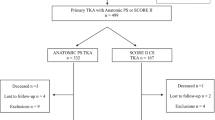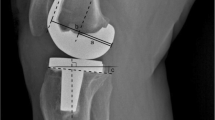Abstract
Purpose
The posterior condylar offset (PCO) and the tibiofemoral contact point (CP) have been reported as important factors that can influence range of motion and clinical outcome after total knee arthroplasty. A mobile-bearing knee implant with an anterior posterior gliding insert would in theory be more sensitive for changes in PCO and CP. For this reason, we analysed the PCO and CP and the relation with outcome and range of motion in 132 patients from a prospectively documented cohort in this type of implant.
Methods
The prosthesis used was a posterior cruciate retaining AP gliding mobile-bearing total knee replacement (SAL II Sulzer Medica, Switzerland). In 132 knees, the pre- and postoperative PCO and postoperative CP were evaluated. Measurements were made on X-rays of the knee taken in approximately 90° of flexion and with less than 3-mm rotation of the femur condyles. The outcome parameters, range of motion (ROM) and the knee society score (KSS), for each knee were determined preoperatively and at 5-year follow-up.
Results
The mean KSS improved from 91 to 161 at 5-year follow-up (p < 0.001) and the mean ROM from 102 to 108 (p < 0.05). The mean PCO difference (postoperative PCO–preoperative PCO) was—0.05 mm (SD 2.15). The CP was on average 53.9 % (SD 5.5 %). ROM was different between the 3 PCO groups (p = 0.05): patients with 3 or more mm decrease in PCO had the best postoperative ROM (p = 0.047). There was no statistical difference between the postoperative ROM between patients with a stable PCO and those with an increased PCO. There was no correlation between the difference in PCO and the difference in ROM; R Pearson = −0.056. There was no difference in postoperative ROM or postoperative total KSS between CP <60 % and CP >60 %: p = 0.22, p = 0.99, for ROM and KSS, respectively. Scatter plots showed uniform clouds of values: increase or decrease in PCO and CP had no significant influence on ROM or KSS.
Conclusion
The hypotheses that a stable PCO and a more natural CP increase postoperative ROM and improve clinical outcome could not be confirmed. On the contrary, a decreased PCO seemed to improve knee flexion. Furthermore, a relationship between PCO and CP could not be found.
Level of evidence
Prospective cohort study, Level II.




Similar content being viewed by others
References
Banks S, Bellemans J, Nozaki H, Whiteside LA, Harman M, Hodge WA (2003) Knee motions during maximum flexion in fixed and mobile-bearing arthroplasties. Clin Orthop Relat Res 410:131–138
Banks SA, Harman MK, Bellemans J, Hodge WA (2003) Making sense of knee arthroplasty kinematics: news you can use. J Bone Joint Surg Am 85-A(Suppl 4):64–72
Bauer T, Biau D, Colmar M, Poux X, Hardy P, Lortat-Jacob A (2010) Influence of posterior condylar offset on knee flexion after cruciate-sacrificing mobile-bearing total knee replacement: a prospective analysis of 410 consecutive cases. Knee 17:375–380
Bellemans J, Banks S, Victor J, Vandenneucker H, Moemans A (2002) Fluoroscopic analysis of the kinematics of deep flexion in total knee arthroplasty. Influence of posterior condylar offset. J Bone Joint Surg Br 84:50–53
Bellemans J, Robijns F, Duerinckx J, Banks S, Vandenneucker H (2005) The influence of tibial slope on maximal flexion after total knee arthroplasty. Knee Surg Sports Traumatol Arthrosc 13:193–196
Bertin KC, Komistek RD, Dennis DA, Hoff WA, Anderson DT, Langer T (2002) In vivo determination of posterior femoral rollback for subjects having a NexGen posterior cruciate-retaining total knee arthroplasty. J Arthroplasty 17:1040–1048
de Jong RJ, Heesterbeek PJ, Wymenga AB (2010) A new measurement technique for the tibiofemoral contact point in normal knees and knees with TKR. Knee Surg Sports Traumatol Arthrosc 18:388–393
Delport HP, Banks SA, De SJ, Bellemans J (2006) A kinematic comparison of fixed- and mobile-bearing knee replacements. J Bone Joint Surg Br 88:1016–1021
Diks MJ, Anderson PG, Janssen JC, van Stralen G, Wymenga AB (2008) The Self-Aligning knee prosthesis: clinical and radiological outcome and survival analysis at 5-year follow up. Knee Surg Sports Traumatol Arthrosc 16:128–134
Feyen H, Van ON, Bellemans J (2012) Partial resection of the PCL insertion site during tibial preparation in cruciate-retaining TKA. Knee Surg Sports Traumatol Arthrosc. doi:10.1007/s00167-012-1997-3
Freeman MA, Pinskerova V (2003) The movement of the knee studied by magnetic resonance imaging. Clin Orthop Relat Res 410:35–43
Hazaki S, Yokoyama Y, Inoue H (2001) A radiographic analysis of anterior-posterior translation in total knee arthroplasty. J Orthop Sci 6:390–396
Insall JN, Dorr LD, Scott RD, Scott WN (1989) Rationale of the Knee Society clinical rating system. Clin Orthop Relat Res 248:13–14
Ishii Y, Noguchi H, Takeda M, Sato J, Toyabe S (2011) Prediction of range of motion 2 years after mobile-bearing total knee arthroplasty: PCL-retaining versus PCL-sacrificing. Knee Surg Sports Traumatol Arthrosc 19:2002–2008
Iwaki H, Pinskerova V, Freeman MA (2001) Femoral roll-back is obtainable and desirable in total knee arthroplasty: the case against. In: Laskin R (ed) Controversies in total knee replacement. Oxford university press, Oxford, pp 106–118
Jeffcote B, Nicholls R, Schirm A, Kuster MS (2007) The variation in medial and lateral collateral ligament strain and tibiofemoral forces following changes in the flexion and extension gaps in total knee replacement: a laboratory experiment using cadaver knees. J Bone Joint Surg Br 89:1528–1533
Kim H, Pelker RR, Gibson DH, Irving JF, Lynch JK (1997) Rollback in posterior cruciate ligament-retaining total knee arthroplasty. A radiographic analysis. J Arthroplasty 12:553–561
Kim YH, Choi Y, Kim JS (2009) Range of motion of standard and high-flexion posterior cruciate-retaining total knee prostheses a prospective randomized study. J Bone Joint Surg Am 91:1874–1881
Kim YH, Sohn KS, Kim JS (2005) Range of motion of standard and high-flexion posterior stabilized total knee prostheses. A prospective, randomized study. J Bone Joint Surg Am 87:1470–1475
Komistek RD, Dennis DA, Mahfouz M (2003) In vivo fluoroscopic analysis of the normal human knee. Clin Orthop Relat Res 410:69–81
Li G, Suggs J, Hanson G, Durbhakula S, Johnson T, Freiberg A (2006) Three-dimensional tibiofemoral articular contact kinematics of a cruciate-retaining total knee arthroplasty. J Bone Joint Surg Am 88:395–402
Malviya A, Lingard EA, Weir DJ, Deehan DJ (2009) Predicting range of movement after knee replacement: the importance of posterior condylar offset and tibial slope. Knee Surg Sports Traumatol Arthrosc 17:491–498
Misra AN, Hussain MR, Fiddian NJ, Newton G (2003) The role of the posterior cruciate ligament in total knee replacement. J Bone Joint Surg Br 85:389–392
Onodera T, Majima T, Nishiike O, Kasahara Y, Takahashi D (2012) Posterior femoral condylar offset after total knee replacement in the risk of knee flexion contracture. J Arthroplasty. doi:10.1016/j.arth.2012.07.029
Shi X, Shen B, Kang P, Yang J, Zhou Z, Pei F (2012) The effect of posterior tibial slope on knee flexion in posterior-stabilized total knee arthroplasty. Knee Surg Sports Traumatol Arthrosc. doi:10.1007/s00167-012-2058-7
Stiehl JB, Dennis DA, Komistek RD, Crane HS (1999) In vivo determination of condylar lift-off and screw-home in a mobile-bearing total knee arthroplasty. J Arthroplasty 14:293–299
Victor J, Banks S, Bellemans J (2005) Kinematics of posterior cruciate ligament-retaining and -substituting total knee arthroplasty: a prospective randomised outcome study. J Bone Joint Surg Br 87:646–655
Author information
Authors and Affiliations
Corresponding author
Rights and permissions
About this article
Cite this article
Geijsen, G.J.P., Heesterbeek, P.J.C., van Stralen, G. et al. Do tibiofemoral contact point and posterior condylar offset influence outcome and range of motion in a mobile-bearing total knee arthroplasty?. Knee Surg Sports Traumatol Arthrosc 22, 550–555 (2014). https://doi.org/10.1007/s00167-013-2525-9
Received:
Accepted:
Published:
Issue Date:
DOI: https://doi.org/10.1007/s00167-013-2525-9




